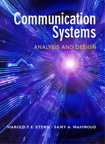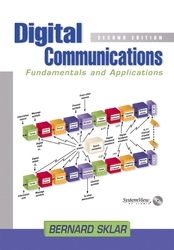Communication Systems: Analysis and Design (Hardcover)
暫譯: 通信系統:分析與設計 (精裝版)
Harold P.E. Stern, Samy A. Mahmoud
- 出版商: Prentice Hall
- 出版日期: 2003-09-14
- 售價: $780
- 貴賓價: 9.8 折 $764
- 語言: 英文
- 頁數: 530
- ISBN: 0131219294
- ISBN-13: 9780131219298
-
相關分類:
通訊系統 Communication-systems
下單後立即進貨 (約5~7天)
買這商品的人也買了...
-
 UML 使用手冊 (The Unified Modeling Language User Guide)
UML 使用手冊 (The Unified Modeling Language User Guide)$580$452 -
 ASP.NET 程式設計徹底研究
ASP.NET 程式設計徹底研究$590$466 -
 Microsoft Windows Server 2003 架站實務
Microsoft Windows Server 2003 架站實務$580$493 -
 鳥哥的 Linux 私房菜-伺服器架設篇
鳥哥的 Linux 私房菜-伺服器架設篇$750$638 -
 鳥哥的 Linux 私房菜─基礎學習篇增訂版
鳥哥的 Linux 私房菜─基礎學習篇增訂版$560$476 -
 Eclipse 實作手冊─活用 Java 整合開發環境 (Eclipse in Action: A Guide for the Java Developer)
Eclipse 實作手冊─活用 Java 整合開發環境 (Eclipse in Action: A Guide for the Java Developer)$450$351 -
 SCJP‧SCJD 專業認證指南 (Sun Certified Programmer & Developer for Java 2 #310-305 與310-027)
SCJP‧SCJD 專業認證指南 (Sun Certified Programmer & Developer for Java 2 #310-305 與310-027)$850$723 -
 人月神話:軟體專案管理之道 (20 週年紀念版)(The Mythical Man-Month: Essays on Software Engineering, Anniversary Edition, 2/e)
人月神話:軟體專案管理之道 (20 週年紀念版)(The Mythical Man-Month: Essays on Software Engineering, Anniversary Edition, 2/e)$480$379 -
 精通 Windows Server 2003 企業網路服務篇 (Mastering Windows Server 2003)
精通 Windows Server 2003 企業網路服務篇 (Mastering Windows Server 2003)$780$663 -
 JSP 2.0 技術手冊
JSP 2.0 技術手冊$750$593 -
 Postfix 技術手冊 (Postfix: The Definitive Guide)
Postfix 技術手冊 (Postfix: The Definitive Guide)$720$569 -
 建構嵌入式 Linux 系統
建構嵌入式 Linux 系統$780$616 -
 Linux 網路管理實務: 調校、帳號、監控、安全
Linux 網路管理實務: 調校、帳號、監控、安全$580$493 -
 電腦專業維修與進階測試
電腦專業維修與進階測試$390$308 -
 CCNA 認證教戰手冊 Exam 640-801 (CCNA Cisco Certified Network Associate Study Guide, 4/e)
CCNA 認證教戰手冊 Exam 640-801 (CCNA Cisco Certified Network Associate Study Guide, 4/e)$780$663 -
 RFID 技術與應用
RFID 技術與應用$480$408 -
 Excel 2003 導引圖鑑
Excel 2003 導引圖鑑$450$356 -
 PowerPoint 專業商務簡報大師
PowerPoint 專業商務簡報大師$380$300 -
 CCNA Cisco Certified Network Associate Study Guide, 5/e (640-801)
CCNA Cisco Certified Network Associate Study Guide, 5/e (640-801)$1,700$1,666 -
 專案管理之美學 (The Art of Project Management)
專案管理之美學 (The Art of Project Management)$620$490 -
 ASP.NET 2.0 深度剖析範例集
ASP.NET 2.0 深度剖析範例集$650$507 -
 Visual C# 2005 程式開發與介面設計秘訣
Visual C# 2005 程式開發與介面設計秘訣$750$593 -
 Ajax 技術手冊 (Foundations of Ajax)
Ajax 技術手冊 (Foundations of Ajax)$450$356 -
 世紀末軟體革命復刻版:C++、GUI 與物件導向理論
世紀末軟體革命復刻版:C++、GUI 與物件導向理論$620$527 -
 軟體工程與 Microsoft Visual Studio Team System (Software Engineering with Microsoft Visual Studio Team System)
軟體工程與 Microsoft Visual Studio Team System (Software Engineering with Microsoft Visual Studio Team System)$480$379
相關主題
商品描述
Using three parallel approaches—rigorous mathematical, graphical, and intuitive—this text offers students a practical and deep understanding of communication systems. Emphasis on the theme of cost vs. performance tradeoffs throughout the book provides a framework and motivation for all the topics examined in it. Fundamentals of frequency domain analysis are reinforced through graphical techniques and communications-oriented examples.
Table of Contents
1. Introduction.
2. Frequency Domain Analysis.
3. Digital Baseband Modulation Techniques.
4. Baseband Receiver Design (and Stochastic Mathematics, Part I).
5. Digital Bandpass Modulation and Demodulation Techniques (and
Stochastic Mathematics, Part II).
6. Analog Bandpass Modulation and Demodulation Techniques.
7. Multiplexing Techniques.
8. Analog-to-Digital and Digital-to-Analog Conversion.
9. Basics of Information Theory, Data Compression, and Image
Compression.
10. Basics of Error Control Coding.
References.
商品描述(中文翻譯)
本書適用於電機工程系的電機工程學生,作為一學期或兩學期的高年級/研究生級別的第一門通訊課程,涵蓋通訊系統和數位通訊。
本書採用三種平行的方法——嚴謹的數學、圖形化和直觀的方式——為學生提供對通訊系統的實用且深入的理解。全書強調成本與性能之間的權衡主題,為所探討的所有主題提供了框架和動機。透過圖形技術和以通訊為導向的範例,加強頻域分析的基本概念。
目錄
1. 介紹。
通訊系統的組成。通訊系統設計中的權衡概述。
2. 頻域分析。
為什麼?傅立葉級數。在頻域中表示功率。傅立葉變換。歸一化能量譜密度。傅立葉變換的性質。使用單位脈衝函數表示離散頻率成分的密度。
3. 數位基帶調變技術。
通訊系統設計的目標。使用矩形脈衝和二進制脈衝振幅調變(PAM)的基帶調變。脈衝整形以提高頻譜效率。構建基帶發射器。
4. 基帶接收器設計(及隨機數學,第一部分)。
計算簡單PAM接收器的位錯誤概率(包括概率和隨機變數的討論)。構建最佳接收器(匹配濾波器或相關接收器)。同步。均衡。多級(M-ary)脈衝振幅調變。
5. 數位帶通調變和解調技術(及隨機數學,第二部分)。
二進制振幅移位鍵控(Binary ASK)。其他二進制帶通調變技術(二進制PSK和FSK)。帶通信號的相干解調。隨機數學 - 第二部分(隨機過程)。ASK和FSK的非相干接收器。差分(非相干)PSK。二進制帶通系統的比較。M-ary帶通技術。
6. 類比帶通調變和解調技術。
傳輸振幅調變(AM)信號。AM信號的相干解調。AM信號的非相干解調。單邊帶和殘餘邊帶AM系統。頻率和相位調變。生成和解調FM和PM信號。類比調變技術的比較。
7. 多工技術。
時分多工。頻分多工。碼分多工。
8. 類比轉數位和數位轉類比轉換。
取樣和量化。差分脈衝編碼調變(DPCM)。增量調變(DM)和連續可變斜率增量調變(CVSD)。
9. 資訊理論、數據壓縮和影像壓縮的基本概念。
獨立來源的資訊內容、熵和資訊速率。用於數據壓縮的可變長度自穿孔碼(包括霍夫曼編碼)。具有依賴消息的來源(包括LZW編碼)。靜態影像壓縮。動態影像壓縮。
10. 錯誤控制編碼的基本概念。
通道容量。代數域理論和模2運算符。漢明碼。錯誤控制編碼的幾何解釋。循環碼。混合FEC/ARQ碼。糾正突發錯誤。卷積碼和維特比解碼。
參考文獻。












